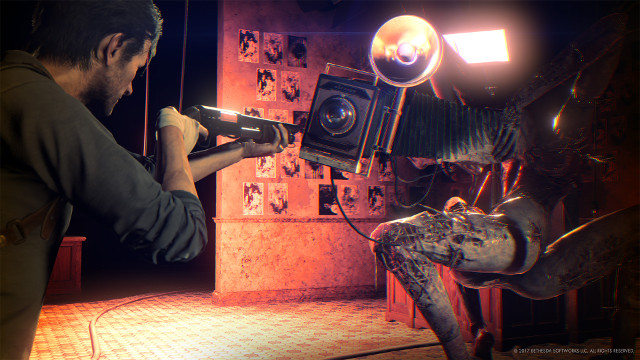While Capcom was off trying to revitalize the Resident Evil series by returning to a creepy, impossibly large building and switching its perspective to first-person, Tango Gameworks were at work on The Evil Within 2, a sequel to Resident Evil 4 director Shinji Mikami’s divisive 2014 game and another return to the third-person, action-oriented take on the survival horror genre that he innovated. Mikami stepped down from The Evil Within 2 prior to its development, handing over its reins to John Johanas and saying that “it was time for the younger talent to do their thing.” The end result is a very different approach, and one that pays off for those who stick with it.
The Evil Within 2 begins in familiar fashion. The impossibly gruff ex-detective Sebastian Castellanos learns that his deceased daughter may not be so deceased after all, with him being tasked with retrieving her from inside a world she’s created using STEM, the system from the first game which uses interconnected minds to create virtual environments. If you weren’t paying much attention the first time around, it’s not tough to figure out what’s going on here — your daughter’s gone walkabouts in a particularly violent world of her own unwitting creation, and you’ve got to find her in a bizarre world where nothing is quite as it seems.
But while The Evil Within 2 initially seems like the next logical next step after the original, with its first true chapter placing you in an eerie stretch of corridors complete with distant shrieks and an encroaching sense of dread, the sequel swiftly shifts gears and decides to become an open-world game. Yes, this time around Sebastian Castellanos is granted a mini-map, objective markers and all the accoutrements you’d expect from a sandbox, except with a survival horror twist.

The Evil Within 2 Review: A disappointing open world
Unfortunately, the open world you’re asked to explore isn’t all that interesting. Referred to as “Union,” it’s essentially Silent Hill minus the fog and the interesting character designs. The majority of the monstrosities you’ll face off against here are your standard zombies, complete with Resident Evil 5-esque head-bursting parasites and a baffling obliviousness to Sebastian’s presence if he crouches near them. These are the standard enemies you’ll face throughout the game, and they present a step down even from the underwhelming zombies Sebastian fended off in the first game.
Also: The Evil Within 2 Guide and Walkthrough: Tips and Strategies for Surviving Union
The Evil Within 2 emphasises stealth, but actually avoiding enemies is as simple as crouching and not walking too close to enemies, with them struggling to find you even in the most obvious of circumstances. Even though ammo conservation is important given its scarcity throughout the game, dispatching these zombies isn’t difficult and they’re far less intimidating than the majority of the monstrosities featured in the first game. It’s a good job, then, that The Evil Within 2 shines when it returns to its predecessor’s linearity, with its interior environments each boasting the distinct personality that its open world is missing.
Sebastian will be confronted by both the new and the old during his journey, and its more tightly constructed stages feature a selection of boss battles that mark a return to the inventive enemy designs of the original game. With the game’s main antagonist being a psychopathic, art-obsessed eccentric, the confrontations that make best use of these themes serve as The Evil Within 2‘s highlights, and the body horror bosses always serve to impress — Obscura and its head camera was a particular favorite. If you find that these confrontations aren’t as difficult as those from the previous game, there’s a tougher difficulty setting specifically tailored to those who want to revisit the challenge of The Evil Within 2‘s predecessor.
Though a significant portion of the first half of the game involves tinkering around in the underwhelming filler that is its open world, as The Evil Within 2 finally begins its lengthy march towards its conclusion in its second half (there’s 17 chapters in total), Tango Gameworks begins throwing a lot of ideas at the wall that stick. While many will feel that the game goes on to outstay its welcome, I felt driven to see what lay around each corner for Sebastian, with its inventive level design routinely throwing up new surprises.
The Evil Within 2 Review: More accessible action
The controls in The Evil Within 2 are less cumbersome this time around, with Sebastian taking up less of the screen in order to place a focus upon the action. While the original game kept the camera close to his back in order to limit the player’s vision and emphasize its survival horror thrills, the more action-oriented approach to its sequel ensures that this wouldn’t have been viable this time around, and weapon handling has also been improved as a result. Sebastian still struggles with keeping his aim steady, and I did sometimes feel as though my headshots didn’t quite register on my targets, but for the most part the game’s combat has been fine-tuned and enemy confrontations are smoother as a result, with a new cover system helping to peer around corners and avoid enemy detection. Some will disapprove of these changes, with many appreciating the clunkiness of the original in the same way that the original Resident Evil games still have their admirers, but it works well for its sequel considering its emphasis upon combat.

The weapons Sebastian picks up can also be improved by way of the game’s new crafting system, which allows players to use resources obtained throughout the game in order to improve a gun’s aim, its fire power or the amount of ammunition it can hold. Players can also craft new ammo for their weapons or health supplies, and while games of this nature often fall into the trap of providing too many resources and thus eliminating the whole “survival” aspect, The Evil Within 2 forces players to remain conservative in regards to how many bullets they’re spraying. A very forgiving checkpoint system ensured that I never felt like I was stuck up shit creek without a paddle, but I still had to keep an eye on my ammo and sometimes revert to my trusty knife rather than waste another bullet. Sebastian can also be upgraded, with the green gel making a reappearance and allowing players to invest in stamina increases, health upgrades and the like.
Unfortunately, aside from these abilities Sebastian is still the same old derivative, beige leading man. He has two discernible personality traits, gruffness and incredulity, with him expressing muted surprise at more-or-less every twist and turn in a game filled with them. Sebastian can go from blithely blowing the head off of a giant woman created from the leftover bits of other women, before being astounded by a blue curtain. “What’s this about?” he asks, before peering behind it. It’s a curtain, mate. You’ve just fended off unimaginable, Lovecraftian horror and this is what stops you in your tracks?
However, while Sebastian remains a boring protagonist, the plot this time around has been improved in that it doesn’t veer into maddening convolution like its predecessor. Though there are certainly more than a few head-scratching revelations and its dialogue is as wonky as ever, I could actually keep track of what was going on this time around, with it being oddly engrossing and endearingly silly. Tango Gameworks aren’t going to win any literary prizes for their work here, but as a way to convince the player to keep pushing on from chapter to chapter, The Evil Within 2‘s story does its job.
In the end, The Evil Within 2 is a worthy sequel that makes a number of bold decisions. For those solely looking for the survival horror thrills of the first game, its spotlight upon combat will likely be a disappointment, as will its introduction of a dull open world. However, there’s plenty tucked away in The Evil Within 2 that will appeal to both fans of the original and new players, with it presenting a mix of Mikami’s best ideas and John Johanas’ new direction. It’s certainly not what I was expecting, but in a good way.
Review based upon PC version of the game. Copy provided by publisher.
-
Excellent and inventive environments.
-
Tighter controls benefit the more action-oriented gameplay.
-
A silly but engaging plot.
-
More accessible than its predecessor.
-
Zombie enemies are very dumb.
-
Open world feels tacked on.
-
Takes a while to pick up steam...
-
...but when it does, it really gets going.











